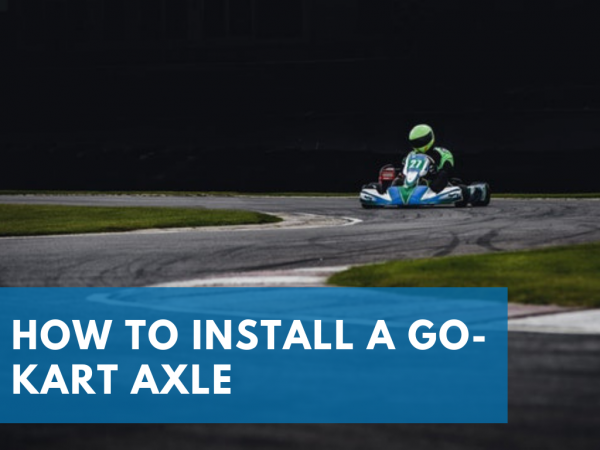How To Install A Go Kart Axle: Things You Should Know

The ability to install a Go Kart axle is a necessary skill if you plan to own a Go-Kart for a long time, or want to build Do It Yourself Go-Karts. The axle is the foundation of the Go-Kart's frame so that a single mistake can cripple your entire Go-Kart. If you follow the steps below, you should understand how to install a Go-Kart axle and minimize the risk of making a mistake.
Removing The Old Axle

Image via Pexels
The first step to replacing a Go-Kart axle is to remove the old axle. This can be difficult because many issues can bind the axle in place. One of the most common issues happens when the ends of the axle are too wide to pass through the axle's dock.
The ends of an axle can mushroom when the installer beats on them with a hammer or weight to force the axle into place during installation. The answer is to beat the ends back in, but this much warping will destroy the axle you’re replacing if it wasn’t ruined already.
You may also need to check for places where the axle has welded together with other parts. Check near the brakes, as the friction caused by their connection can heat the axle and cause warping.
If screws are stripped bare, or if lubricant in connectors has dried, these can also cause sticking. In these cases, you may need to manually file the bolts on your axle away to separate it from the Go-Kart.
Review Your Go-Kart Frame Before Starting
Once you have your new axle, take the time to examine the frame of your Go-Kart. If the axle mount is bent, or the holes aren't straight, this can make it difficult to install a straight axle.
You should also check your new axle before you start to make sure it is aligned. If you see even a slight curvature from end to end, or burrs have formed before you install it, you may want to straighten it.
If both the axle mount and the axle itself are aligned, you should be able to slide the axle in without needing to beat it in place with a hammer or object. A bent axle or mount also increases the chance of friction and warping when you use your Go-Kart, which will make removing it later much harder.
If the axle slides between the bearings without trouble, then both the bearings and the axle should be in alignment. Take this time to mark your axle where any screws touch, so that when you install it for good later, you can quickly align these points again.
Remove Burrs And Imperfections
A burr refers to a point in the metal that’s been flattened by the pressure on it. The axle and connected parts should be curved, so burrs are usually easy to recognize.
Once you’ve confirmed your axle can fit the mount, remove it and begin cleaning the system underneath your Go-Kart. This is the best time to add new lubricant to bearings and other joints. Check for worn brakes, because friction from damaged brakes could quickly damage your new axle.
Ask to borrow a ball hone, or purchase one if you can. This tool is used to soften burrs and bend them back into place, ensuring your axle and frame both have the appropriate measurements when the time comes to finish the installation.
Check to see if the bearings that the axle are going to fit into are too small. Manufacturers can sometimes misjudge the size of the bearings you will slot your axle into. If it's even a few millimeters too thin, the axle may not fit. Use Scotch-Brite on the inside of the bearing to expand it the few millimeters necessary, but be careful not to make the bearing too large.
Add The Brake Rotor And Carrier

Image via Pexels
At this point, you should apply lubricant to the brake rotor before connecting it to the axle. Another option is to loosen the brake rotor from the carrier, but you should attempt lubrication first. If loosening the rotor is necessary, remember to tighten it again once the axle, the brake rotor, and the carrier are all connected.
Don’t forget the brake rotor key once you’ve fastened the entire system together You should also make sure to attach any water pump o-rings that go with your Go-Kart’s axle, brake rotor, and carrier.
If you’ve installed the brake rotor and the brake rotor carrier correctly, then the axle, rotor, and carrier should all be one combined piece. This is the system you’ll be using when you install your axle to your Go-Kart using the instructions below.
Installation Step By Step
Now that you've taken all of the steps required to check your Go-Kart's axle mount, and make sure your new axle doesn't have any blemishes, you can begin the installation. Although this guide primarily focuses on installing the axel, if the bearings or any other parts seemed damaged during your inspection, you may wish to choose to install those first before beginning.
Loosen The Bearings And Bolts

Image via Pexels
Your axle will be slid in through three bearings when you begin. To start, loosen the third bearing on your Go-Kart. The third bearing should be the middle bearing. You won’t tighten this bearing again until all screws have been tightened in the two other bearings later in this guide.
Carriers can have a different number of bolts, but it's recommended you install only three on each side for now. If your carrier has additional bolts, you can add and tighten them later once you have installed the axle
Slide The Axle Through Two Bearings
Now that you're permanently installing the axle apply lubrication to the axle. The only place you shouldn't apply grease is the location you're going to be using as a handhold.
Use your handhold to slide the axle in from the engine side of your Go-Kart. Make sure it slides through the first bearing and the third bearing that you loosened in the previous step.
You should attach any water pump o-rings now if you’ve forgotten them. Additionally, you should position the brake rotor inside the caliper, and make sure it is facing the right direction. This isn’t necessary for all brake rotors, but some axles require proper key placement to be installed correctly.
Slowly Begin To Guide It Through The Last Steps

Image via Pexels
At this point, push the axle into the brake rotor carrier. You may want to slowly turn it as you do so, to make sure it is not bent and has proper freedom of movement.
Once the axle is through the brake rotor carrier, push it through the final bearing on the side of your Go-Kart opposite the engine. If it doesn’t slide through the left bearing, it is likely that some part of your axle’s system is out of alignment. You should check for any bends in your axle, the bearings, and the brake carrier.
It’s possible to use a flat mallet, hammer, or heavy object to force your axle through the last bearing. If this is required your axle may be bent and can cause you difficulty later, however. As addressed earlier, beating an axle in place can also mushroom the end of the axle, making it difficult to remove later.
The best advice if you have an issue with your axle at this point is to pause. If the bearing isn't wide enough you should take the time to grind the opening of the bearing. If the axle doesn't fit due to a burr, try rounding the axle again. It is just as common for an axle not to fit as it is for the bearings or the axle to be out of alignment, so identifying the correct problem is important.
If you have a brake rotor carrier key, now is the time to connect it. With that, your axle and braking system should be in place. Rotate the axle to ensure it has freedom of movement, and check for stiffness in any of the joints.
Check The Axel’s Alignment
Once your axle is in place, you should measure the parts of the axle that extends past the outside bearings. If the axle sticks out more on one side, then your axle isn't centered and can damage your chassis.
Make sure that your axle is centered, and measure it carefully with whatever tools are on hand. If it sticks out an inch on the left side, it should stick out exactly one inch on the right side as well. This process can greatly affect handling and the lifespan of your axle.
Tighten The Screws
With the axle in place, it's now time to tighten the entire system to ensure it doesn't slide out of place. If you placed marks where the screws would push into the axle during the test installation of the axle, rotate the axle so that those align now.
Begin tightening the screws now. If you followed the advice above and used only three screws, you can now place all remaining screws into the bearings around the axle. Don’t tighten the bearings too much, or you risk flattening areas of the axle and creating burrs.
One thing you can do is use an adhesive approved for mechanical use, such as Loc-Tite, to fasten the screws in place for a tighter seal. You should apply this once the screws have been tightened to a comfortable degree to hold the bearing in place.
The Final Bearing
The third bearing in the center is the one you should tighten at this point. While you tighten the final bearing, you should rotate the axle regularly, to make sure that there is no bind and it is not being held too stiffly anywhere along the axle.
The most important part of this phase is to check the entire axle system to make sure that nothing is installed too tightly. If bearings are clenched too tightly, they can create burrs that prevent the axle from working properly. Fastening screws and bolts too stiffly can reduce movement, and they may be worn off due to friction when you start driving later.
Once you’re done adding the third bearing’s bolts, you are finished with the axle’s installation. Like the other two bearings, you can add more than three bolts, but test the axle after each installation to ensure the axle is bound too tightly.
Center The Brake Rotor Carrier Again
While you were tightening the bearings and checking the bolts on each end of the axle, the brake rotor carrier likely slid out of place. At this point, make sure to adjust the brake rotor carrier again and measure to make sure it is centered in the exact middle of your axle system.
Once you've tightened the brake rotor carrier in place, you should check to make sure the axle spins freely again. Although we've mentioned this step ad nauseam, you should check to make sure the axle spins freely as many times as it takes until you feel comfortable.
Friction is one of the easiest ways to reduce your new axel’s lifespan. If anything is installed too tightly, consider loosening it a bit without compromising the system. The other common issue is alignment, so make sure that both your axle and brake rotor carrier are centered to a very precise degree.
Double Check Everything
Once you've finished the installation, make sure to closely examine every part of your chassis. Even professional mechanics often forget to attach a simple part like the water pump o-rings. It's also possible that a part fell out or that you bumped a part out of place during later steps of the installation.
If everything is in place, then your installation of a Go-Kart axle should be complete. You can't install a Go-Kart axle without balancing several Go-Kart parts, so diligence is key even when using a guide. Once you've reviewed your axle for a second time, it's time to take to the driver's seat and test your hard work while having a bit of fun.
